- No results found
- Use cases
- Co-Creation Space
Community
Organizations
Collaboration Partners
- Login
NOT REGISTERED YET?
Register for the Use Case Management Service for free to start creating your first use case.
Registered users can use the download area and the comment functions.

All documents are licensed as a Creative Commons Attribution-NonCommercial-ShareAlike 4.0 International License
(Attribution-Non-Commercial-ShareAlike 4.0). Further information can be found at
![]()
These documents do not claim to be complete. Nor are they to be understood in the sense of a recommendation or guideline that is generally valid from a legal point of view, but are intended to support the client and contractor in applying the BIM method. The use cases must be adapted to the specific project requirements. The examples given here do not claim to be complete. Information is based on practical experience and should therefore be regarded as best practice and not generally applicable. As we are in a phase in which definitions are only just emerging, the publisher cannot guarantee the accuracy of individual contents.
This document aims at describing Assessing operational energy costs and energy performance of buildings using measured data use case which is implemented as part of BIM-SPEED EU Horizon2020 project, under grant agreement No. 820553, https://www.bim-speed.eu/en. https://www.bim-speed.eu/en, using the ECOtool, developed by CARTIF https://www.cartif.es/en/ and adapted in task 5.2: Interoperability between multidisciplinary BIM tools and services to comply with the Key Performance Indicators (KPIs) defined in task 4.1: Baseline, KPI and Use Case definition and verification of the BIM-SPEED project. This use case allows to automate the calculation of a set of economic and environmental indicators related to the occupation and maintenance phases of the building renovation, to use it in different phases of the renovation process.
The ‘ECOtool Service’ implemented as part of BIM-SPEED project is developed with the need for the objectives set by the BIM-SPEED Project. It helps in:


Automate the calculation of a set of economic and environmental indicators related to the occupation and maintenance phases of the building renovation.
The comparison between the conventional practices to obtain the calculation of a set of economic and environmental indicators related to the occupation and maintenance phases of the building renovation process, with the use of the BIM-SPEED solution (ECOtool Service), as realized from implementation on demonstration sites, is shown in the image below:

The tool needs different inputs from the users, if these values are not correct, the results obtained will be incorrect.
The exchange requirements of the ECOtool are the following:
INPUTS:
OUTPUTS:
The overall process for ECOtool service is presented in the figure below. The procedure starts with the energy data collection at the building/dwelling level by the user. The overall process is further explained through its implementation on one demonstration site.
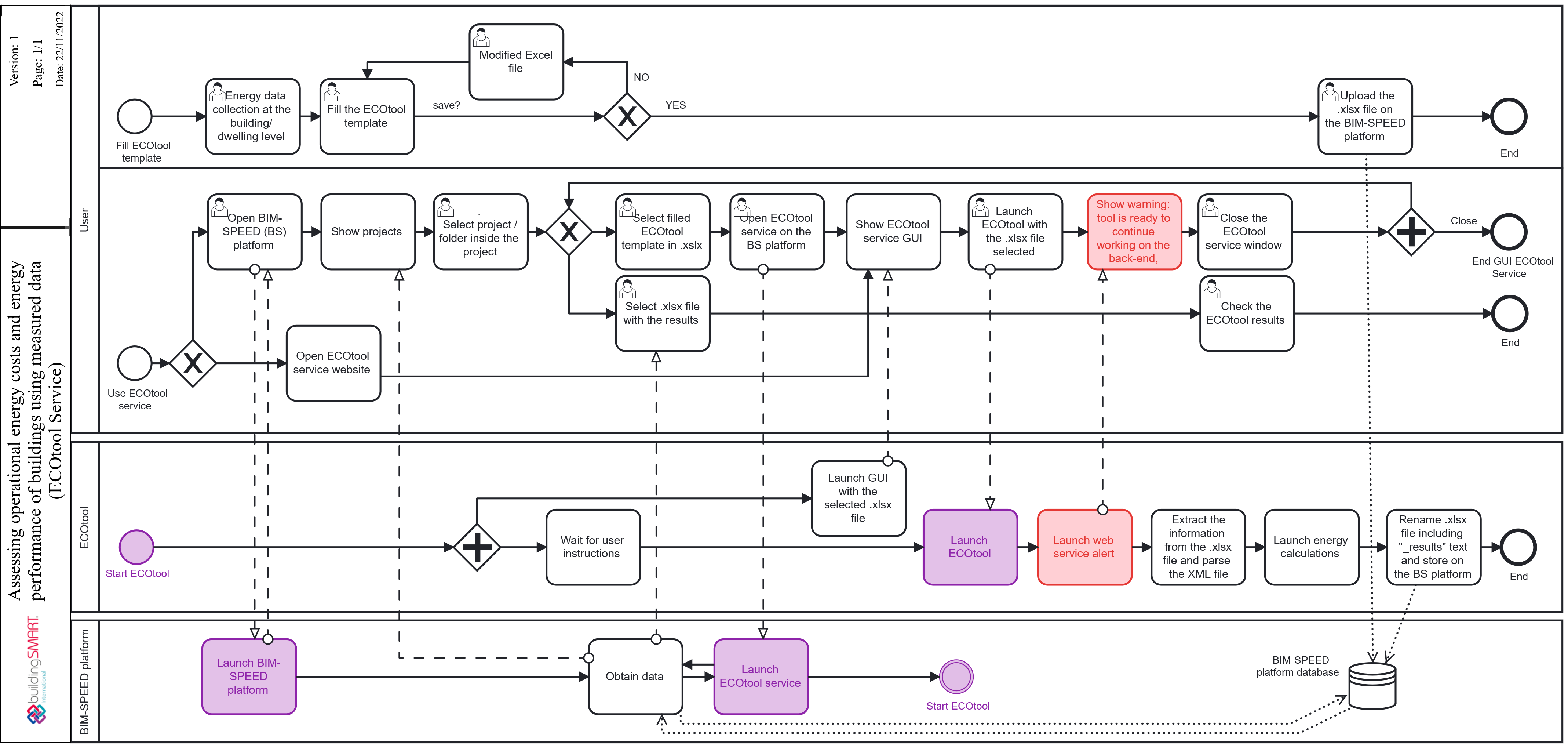
As shown in the image above, there are four different parts involve in the process: the user, the ECOtool Service, and the BIM‑SPEED platform:
The details of the implementation of this tool in a demonstration cases are covered in the next section.
DEMONSTRATION SITE – ARCAYA5 and ALDABE26, VITORIA, SPAIN
The demonstration site is located in Vitoria-Gasteiz, Spain, with the residential building Manuel Díaz ARCAYA5 (MDA5) and ALDABE26 (ALD26), included as demo cases of the BIM-SPEED project.
The first step is to download the template that will be used to include energy consumption information. As shown in the image below, the user needs to access the usage agreement before downloading it:
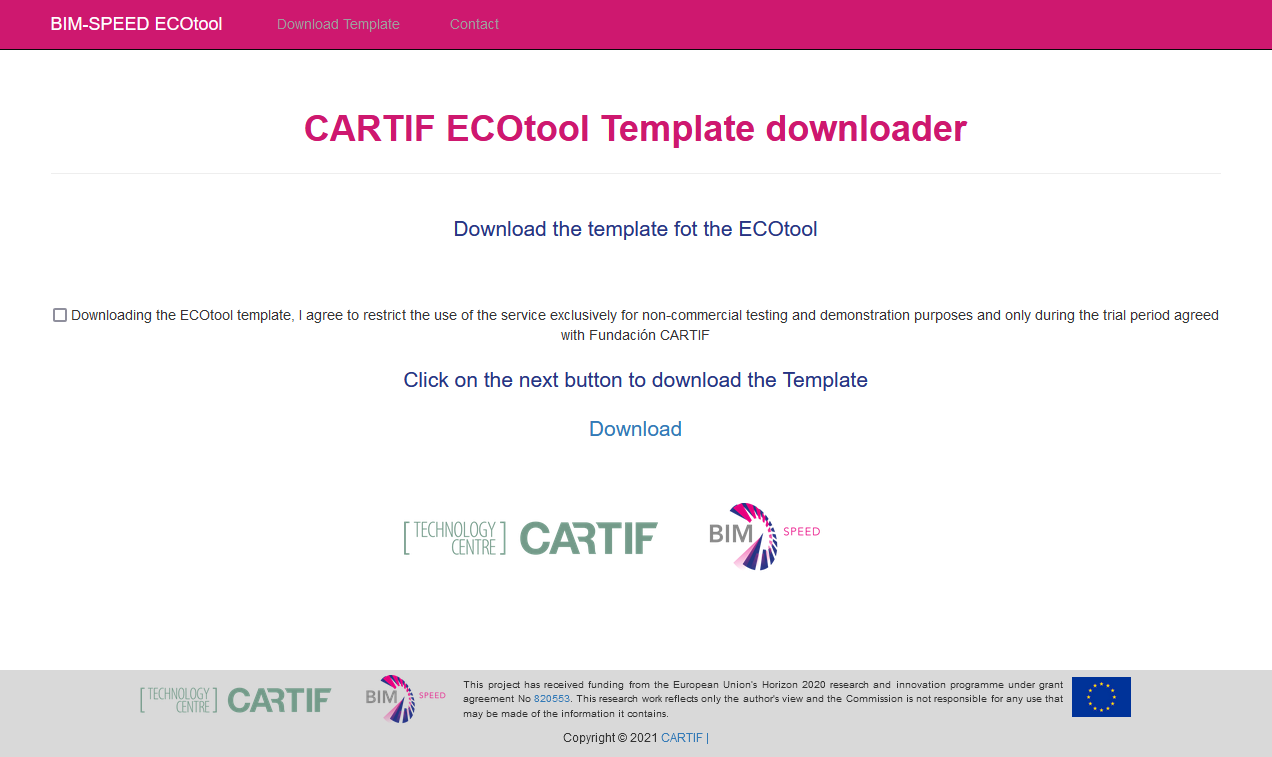
Once the owner of each building has collected the data needed to complete the template used as input for the ECOtool, previously downloaded from the ECOtool service, the next step is to complete the template and upload it to the project folder. Using the data provided by the owner, the information collected by the MDA5 building is:
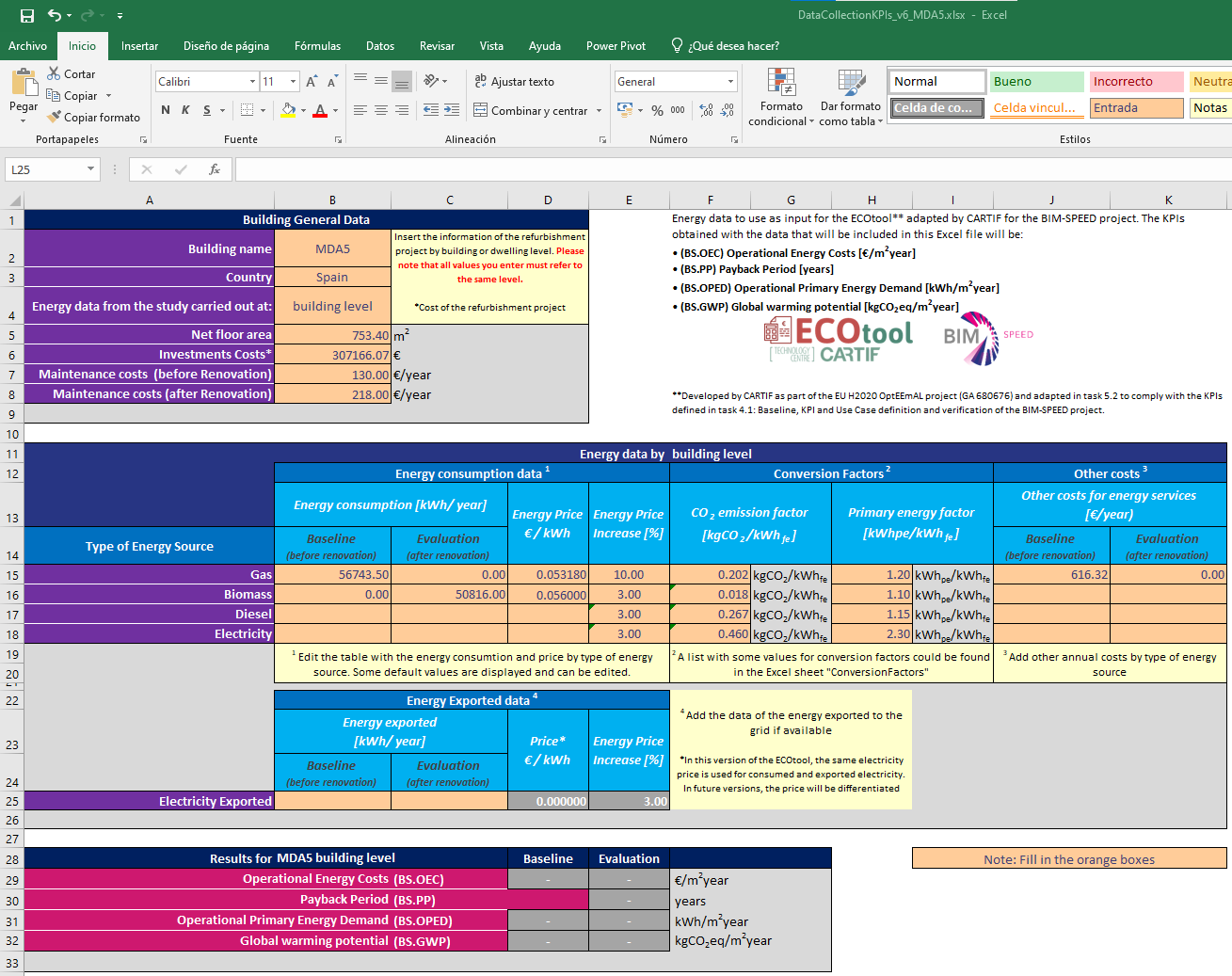
And for the ALD26 building, the information provided by the owner is:
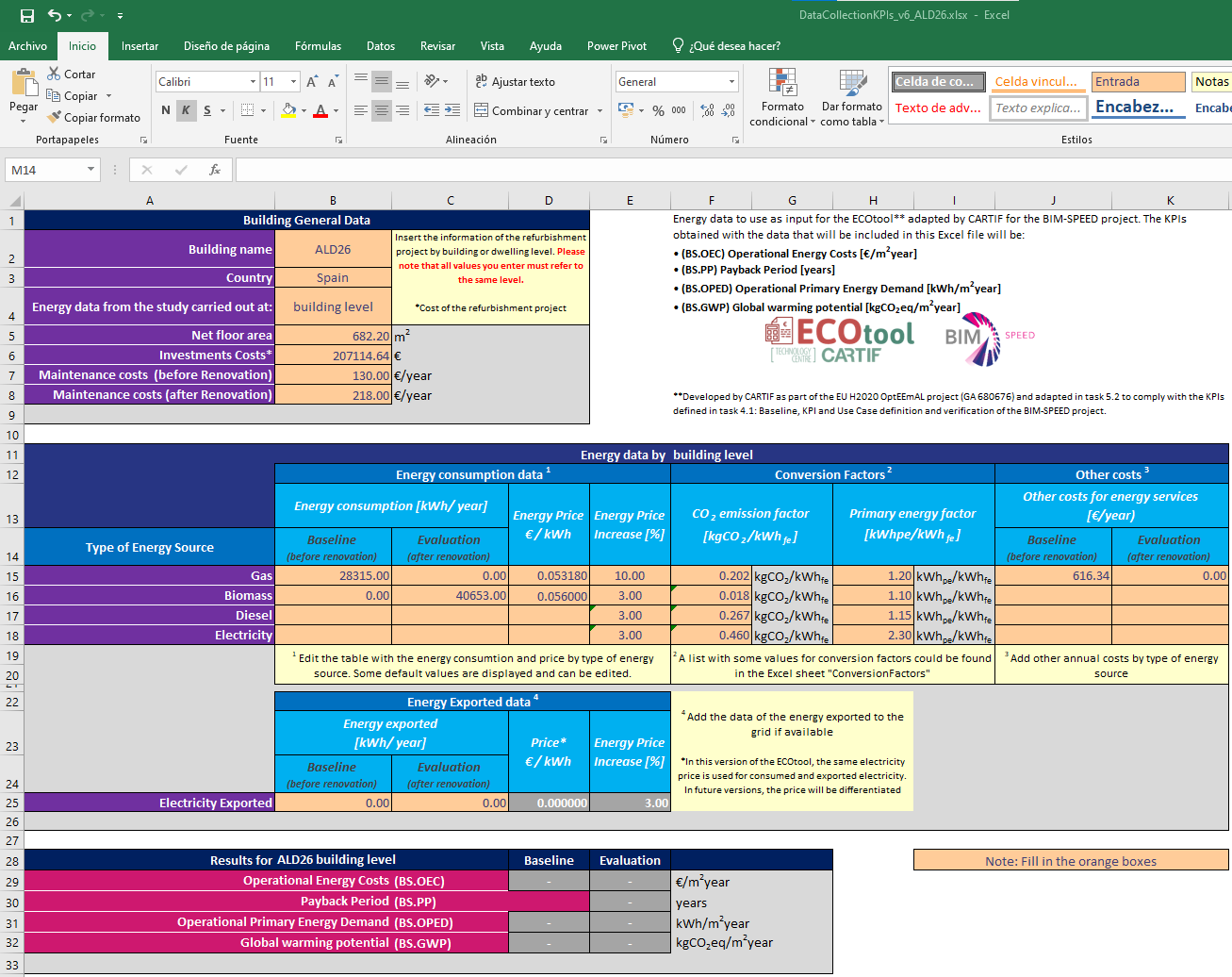
Once the template of the both buildings are completed, the next step was to launch the ECOtool service through the BIM-SPEED platform. As shown in the image below, the .xlsx file of the building is automatically loaded into the tool:
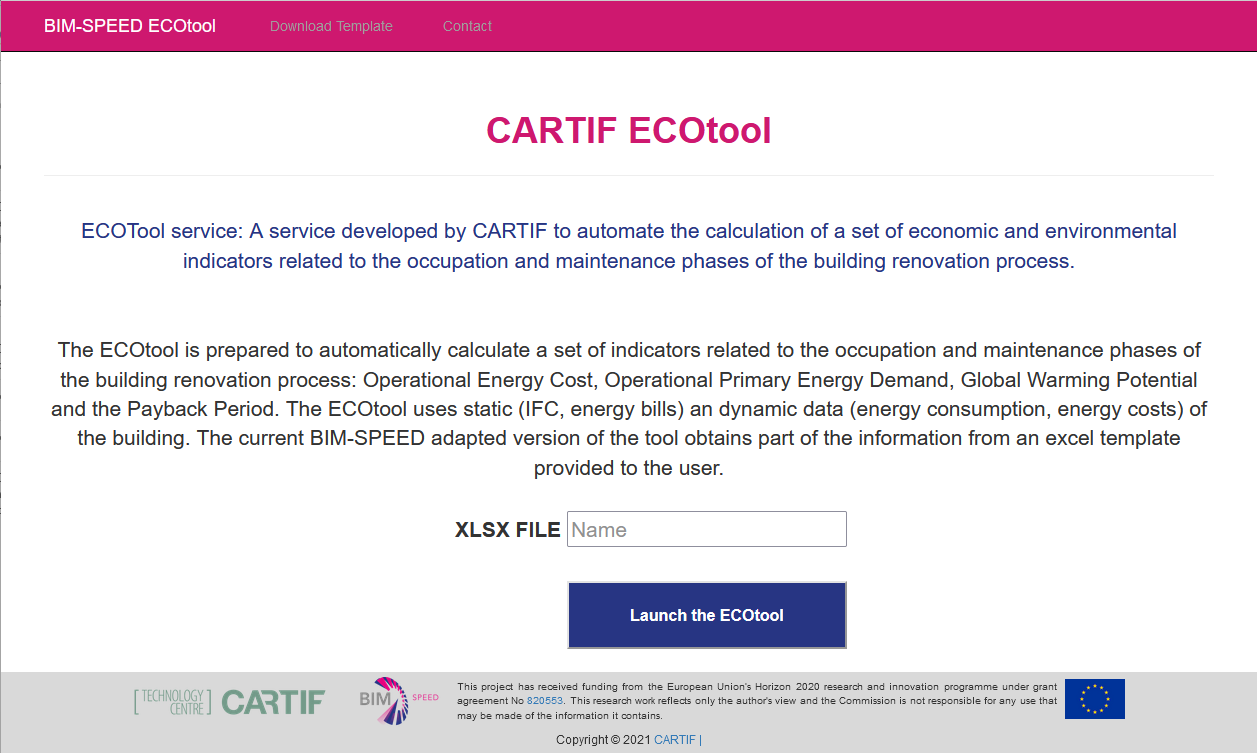
After launch the tool, in the interface a warning appears, indicating that you can now close the tool's interface. As shown in the image below:

The results in .xlsx format were stored in the BIM-SPEED platform automatically:
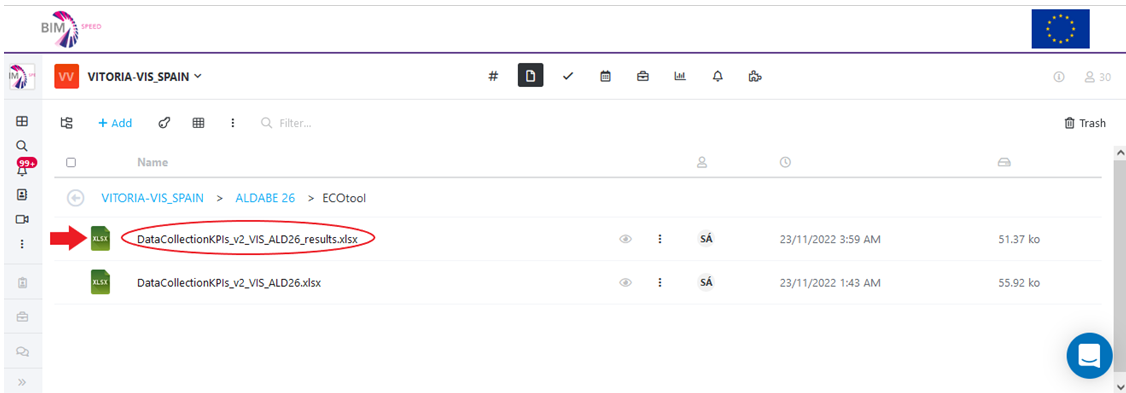
These results of the calculation are shown in the figure below, where it can be seen that the options chosen in the renovation for the each building considerably reduce all the indicators, except the Payback period, which is still higher than 100 years.
For the MD5 building, the results are:
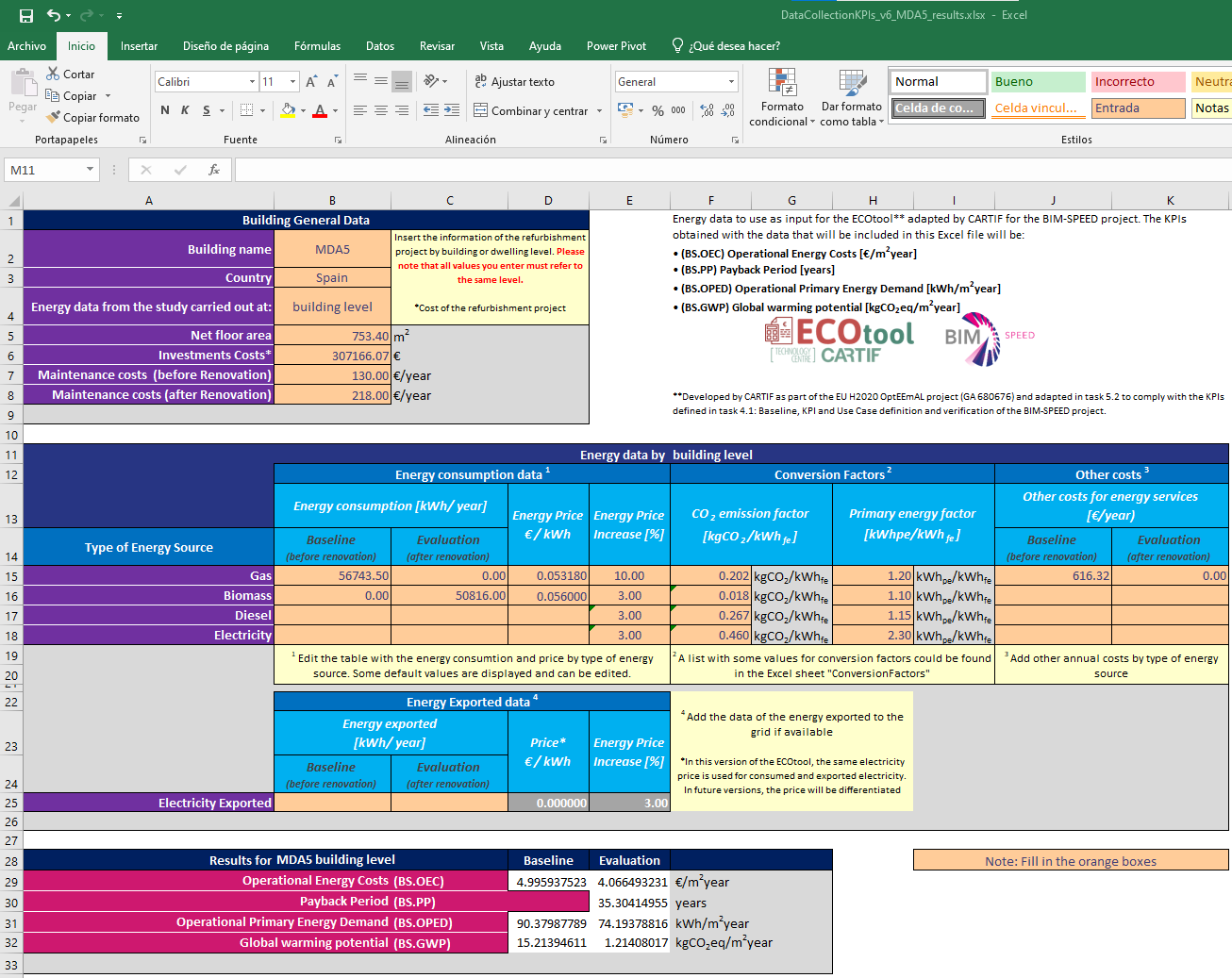

The results obtained show a clear reduction in all calculated indicators, compared to the baseline status. The operational primary energy demand has been reduced compared to the baseline data, and the payback period is 35.30 years. The GWP is also considerably reduced with the renovation proposal used.
For the ALD26 the results obtained are:
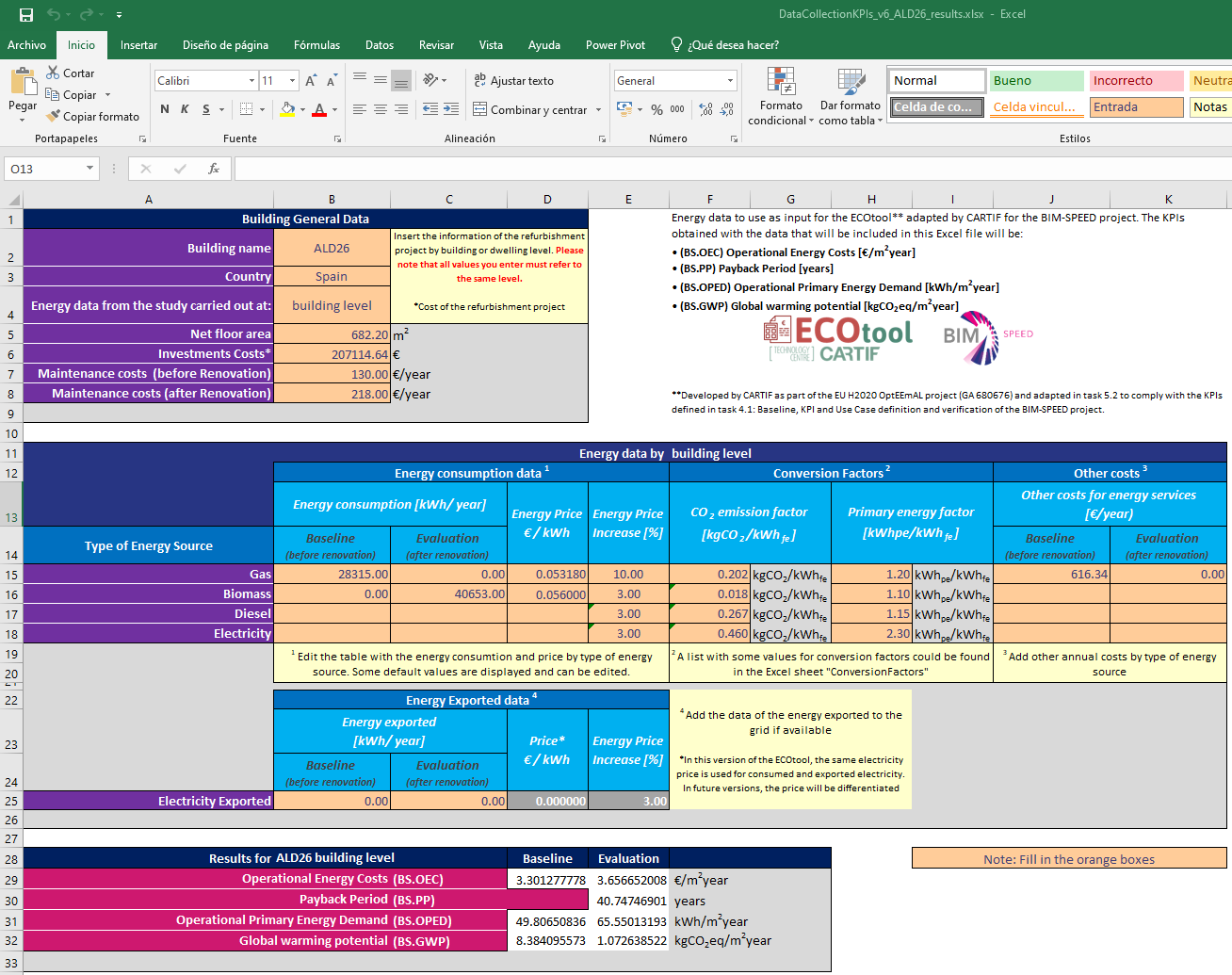

This building (ADB26) shows a greater reduction in GWP than the previous one, and the payback period is 40.74 years. This building has an increase in OEC and OPED, with renovation only being efficient if the indoor thermal comfort of the dwellings has been achieved, compared to the state before the building was renovated.
DEMONSTRATION SITE – Duplex building in Gdynia, POLAND
The demonstration site is located in Gdynia, Poland, with a duplex building, included as demo case of the BIM-SPEED project. The steps to follow are the same that the explained for the demo site explained before
Once the owner of the building has collected the data needed to complete the template used as input for the ECOtool, previously downloaded from the ECOtool service, the next step is to complete the template and upload it to the project folder. Using the data provided by the owner, the information collected by the Gdynia building is:
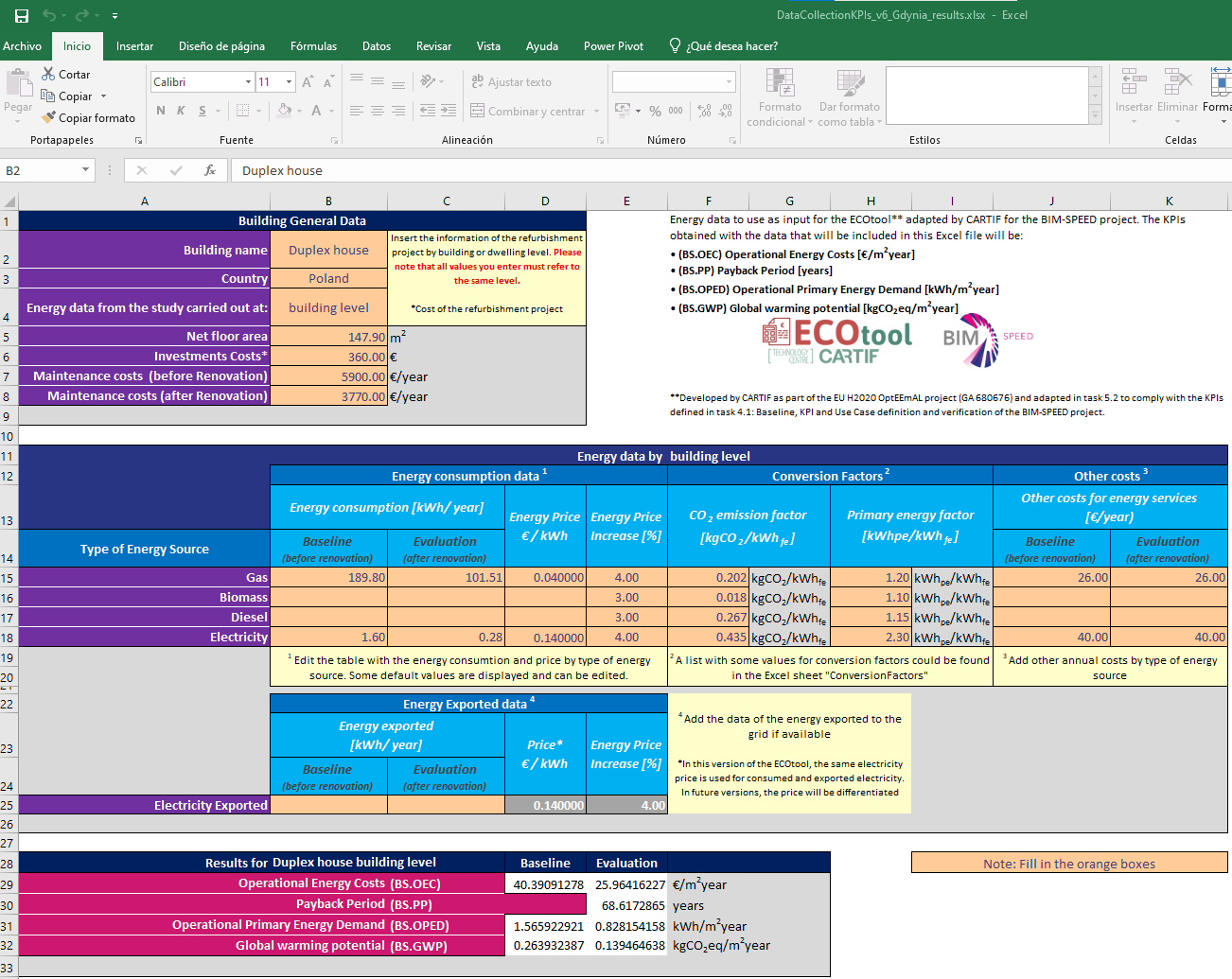
The results obtained from this demo, using the data provided by the owner are:

With these results, we can deduce that the proposed intervention has significantly reduced the Operational Primary Energy Demand, and the GWP has been considerably reduced. The Operational Energy Costs are lower than in the baseline, its reduction is almost half compared to the baseline. The Payback Period is 68.62 years. The intervention is not cost-effective in terms of return on investment, but it is cost-effective in environmental terms.
The ECOtool defines in this document allows to achieve a reduction of time in the calculation of a set of indicators related to the occupation and maintenance phases of the building renovation process: Operational Energy Cost, Operational Primary Energy Demand, Global Warming Potential and the Payback Period, compare with the conventional practices that means do not use the ECOtool to automatize these calculations. This process is faster and more accurate than the manual process because it is a mathematical process based on defined equations
The ECOtool service is integrated into BIM-SPEED platform and accessible from there. The service is available in the platform if there is an IFC file.
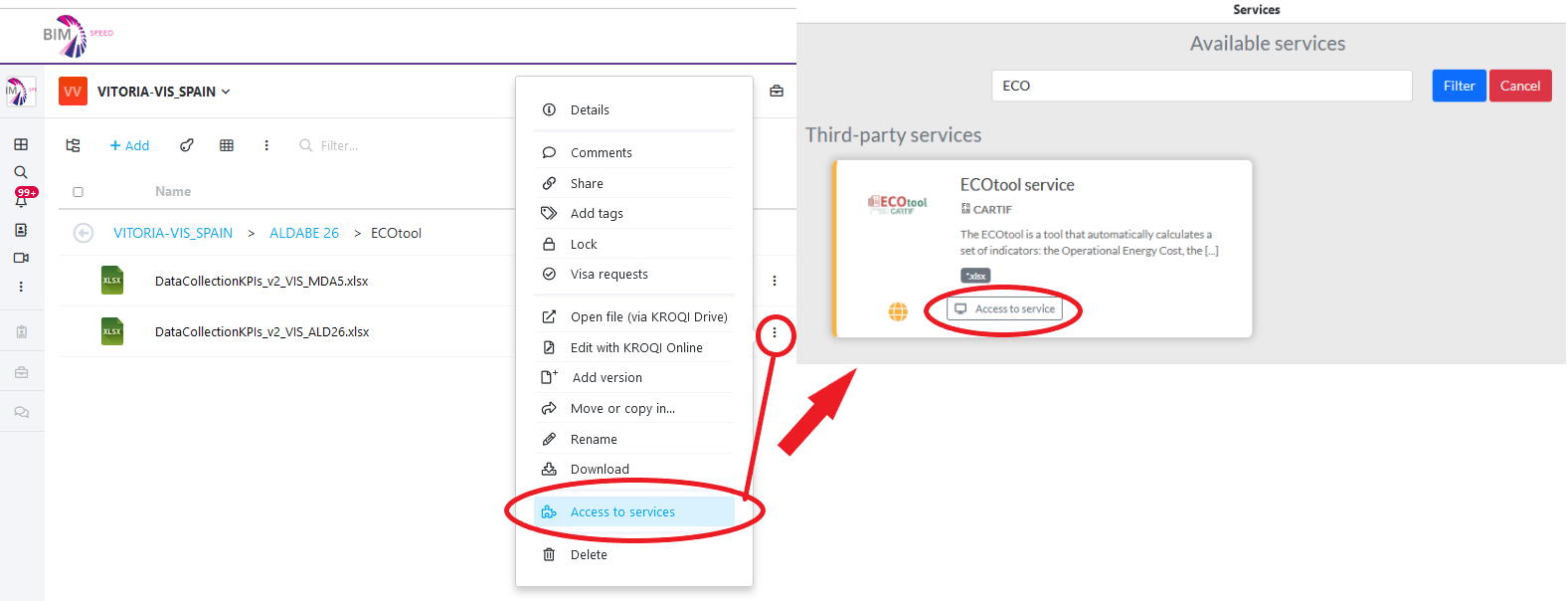
After launch the ECOtool service, the selected .xlsx file is loaded directly in the ECOtool service, as shown in the figure below:
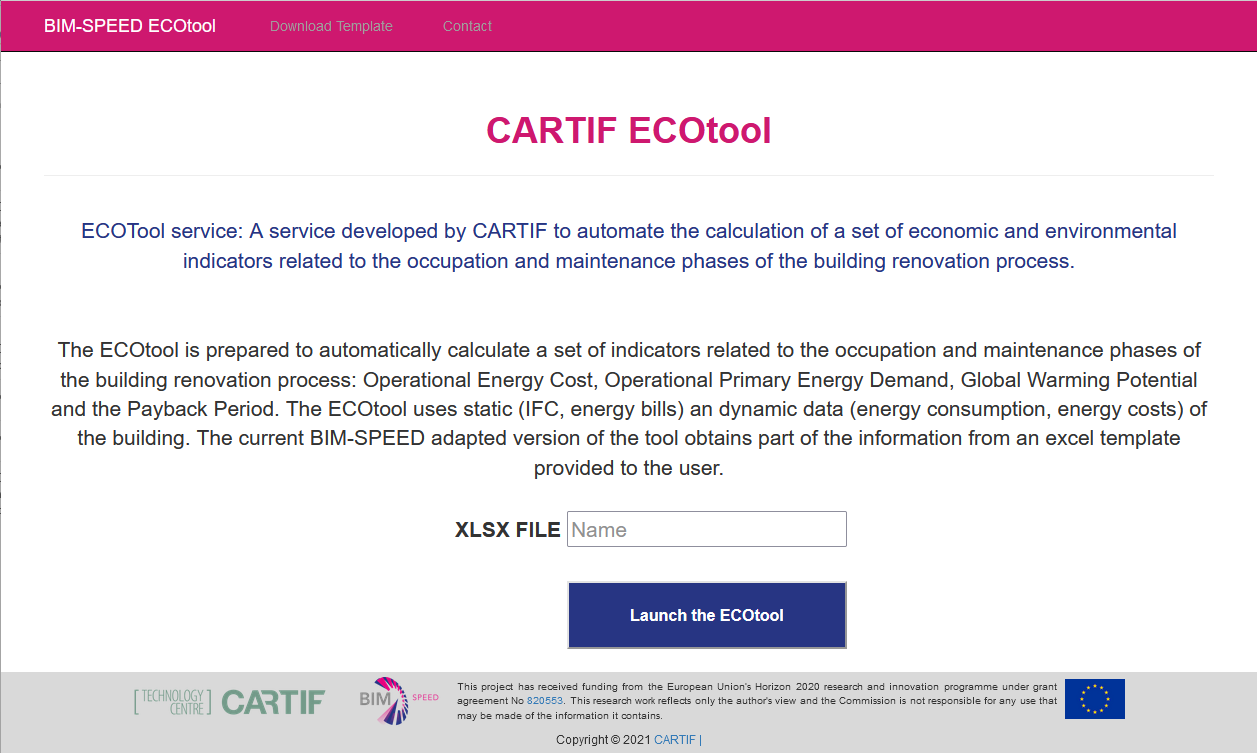
Once the ECOtool is launched, a warning appears to indicate to the user that the tool is working on the back-end and the tool interface can be closed.
The last step of the process is upload the .xlsx results on the BIM-SPEED platform.
In the design phase of a deep renovation project it is important to know how the changes in consumption that are going to take place in the actions to be carried out in the building or dwelling will affect different economic indicators in terms of energy, as well as in terms of environmental impact with CO2 emissions. Tools such as ECOtool shown in this Use case have been developed to facilitate users' decision making when deciding to act on the consumption of different energy sources needed by the building in its operation and maintenance phase.